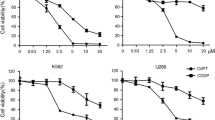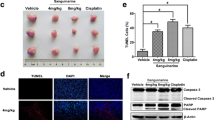Abstract
Cobalt promotes apoptosis in multiple cell systems, however, the molecular mechanisms that influence cobalt-induced apoptosis are not fully understood. We investigated mechanisms of cobalt chloride induced apoptosis in HCT116 colorectal cancer cells. Cobalt chloride induced dose dependent apoptosis in HCT116 cells (250–750 μM) which, at higher concentrations (500–750 μM), was associated with an increase in the expression of the Bcl-2-related Mcl-1 survival protein. Cobalt chloride caused the accumulation of higher molecular weight ubiquitin-conjugates of Mcl-1 in intact HCT116 cells and inhibited the activity of the trypsin-like site of the 20S proteasome in an in vitro assay. Although siRNA-mediated knockdown of Mcl-1 increased apoptosis in HCT116 cells, the combination of Mcl-1 siRNA and cobalt chloride induced very high levels of cell killing. Therefore, inhibition of the proteasome by cobalt chloride leads to the accumulation of Mcl-1 which acts to limit cobalt chloride induced apoptosis.







Similar content being viewed by others
References
Kesteloot H, Roelandt J, Willems J, Claes JH, Joossens JV (1968) An enquiry into the role of cobalt in the heart disease of chronic beer drinkers. Circulation 37:854–864
Wehner AP, Busch RH, Olson RJ, Craig DK (1977) Chronic inhalation of cobalt oxide and cigarette smoke by hamsters. Am Ind Hyg Assoc J 38:338–346. doi:10.1080/0002889778507627
Jordan CM, Whitman RD, Harbut M (1997) Memory deficits and industrial toxicant exposure: a comparative study of hard metal, solvent and asbestos workers. Int J Neurosci 90:113–128
Lison D, De Boeck M, Verougstraete V, Kirsch-Volders M (2001) Update on the genotoxicity and carcinogenicity of cobalt compounds. Occup Environ Med 58:619–625. doi:10.1136/oem.58.10.619
De Boeck M, Kirsch-Volders M, Lison D (2003) Cobalt and antimony: genotoxicity and carcinogenicity. Mutat Res 533:135–152. doi:10.1016/j.mrfmmm.2003.07.012
Olivieri G, Hess C, Savaskan E et al (2001) Melatonin protects SHSY5Y neuroblastoma cells from cobalt-induced oxidative stress, neurotoxicity and increased beta-amyloid secretion. J Pineal Res 31:320–325. doi:10.1034/j.1600-079X.2001.310406.x
Zou W, Yan M, Xu W et al (2001) Cobalt chloride induces PC12 cells apoptosis through reactive oxygen species and accompanied by AP-1 activation. J Neurosci Res 64:646–653. doi:10.1002/jnr.1118
Araya J, Maruyama M, Inoue A et al (2002) Inhibition of proteasome activity is involved in cobalt-induced apoptosis of human alveolar macrophages. Am J Physiol Lung Cell Mol Physiol 283:L849–L858
Zou W, Zeng J, Zhuo M et al (2002) Involvement of caspase-3 and p38 mitogen-activated protein kinase in cobalt chloride-induced apoptosis in PC12 cells. J Neurosci Res 67:837–843. doi:10.1002/jnr.10168
Kim HJ, Yang SJ, Kim YS, Kim TU (2003) Cobalt chloride-induced apoptosis and extracellular signal-regulated protein kinase activation in human cervical cancer HeLa cells. J Biochem Mol Biol 36:468–474
Catelas I, Petit A, Zukor DJ, Antoniou J, Huk OL (2003) TNF-alpha secretion and macrophage mortality induced by cobalt and chromium ions in vitro-qualitative analysis of apoptosis. Biomaterials 24:383–391. doi:10.1016/S0142-9612(02)00351-4
Huk OL, Catelas I, Mwale F, Antoniou J, Zukor DJ, Petit A (2004) Induction of apoptosis and necrosis by metal ions in vitro. J Arthroplasty 19:84–87. doi:10.1016/j.arth.2004.09.011
Yang SJ, Pyen J, Lee I, Lee H, Kim Y, Kim T (2004) Cobalt chloride-induced apoptosis and extracellular signal-regulated protein kinase 1/2 activation in rat C6 glioma cells. J Biochem Mol Biol 37:480–486
Petit A, Mwale F, Zukor DJ, Catelas I, Antoniou J, Huk OL (2004) Effect of cobalt and chromium ions on bcl-2, bax, caspase-3, and caspase-8 expression in human U937 macrophages. Biomaterials 25:2013–2018. doi:10.1016/j.biomaterials.2003.08.040
Ardyanto TD, Osaki M, Tokuyasu N, Nagahama Y, Ito H (2006) CoCl2-induced HIF-1alpha expression correlates with proliferation and apoptosis in MKN-1 cells: a possible role for the PI3K/Akt pathway. Int J Oncol 29:549–555
Caicedo M, Jacobs JJ, Reddy A, Hallab NJ (2007) Analysis of metal ion-induced DNA damage, apoptosis, and necrosis in human (Jurkat) T-cells demonstrates Ni(2+) and V(3+) are more toxic than other metals: Al(3+), Be(2+), Co(2+), Cr(3+), Cu(2+), Fe(3+), Mo(5+), Nb(5+), Zr(2+). J Biomed Mater Res A
Akita K, Okamura H, Yoshida K, Morimoto H, Ogawa-Iyehara H, Haneji T (2007) Cobalt chloride induces apoptosis and zinc chloride suppresses cobalt-induced apoptosis by Bcl-2 expression in human submandibular gland HSG cells. Int J Oncol 31:923–929
Karovic O, Tonazzini I, Rebola N et al (2007) Toxic effects of cobalt in primary cultures of mouse astrocytes. Similarities with hypoxia and role of HIF-1alpha. Biochem Pharmacol 73:694–708. doi:10.1016/j.bcp.2006.11.008
An WG, Kanekal M, Simon MC, Maltepe E, Blagosklonny MV, Neckers LM (1998) Stabilization of wild-type p53 by hypoxia-inducible factor 1alpha. Nature 392:405–408. doi:10.1038/32925
Ke Q, Costa M (2006) Hypoxia-inducible factor-1 (HIF-1). Mol Pharmacol 70:1469–1480. doi:10.1124/mol.106.027029
Gordan JD, Simon MC (2007) Hypoxia-inducible factors: central regulators of the tumor phenotype. Curr Opin Genet Dev 17:71–77. doi:10.1016/j.gde.2006.12.006
Brahimi-Horn C, Pouyssegur J (2006) The role of the hypoxia-inducible factor in tumor metabolism growth and invasion. Bull Cancer 93:E73–E80
Vengellur A, LaPres JJ (2004) The role of hypoxia inducible factor 1alpha in cobalt chloride induced cell death in mouse embryonic fibroblasts. Toxicol Sci 82:638–646. doi:10.1093/toxsci/kfh278
Packham G, Stevenson FK (2005) Bodyguards and assassins: Bcl-2 family proteins and apoptosis control in chronic lymphocytic leukaemia. Immunology 114:441–449. doi:10.1111/j.1365-2567.2005.02117.x
Bruick RK (2000) Expression of the gene encoding the proapoptotic Nip3 protein is induced by hypoxia. Proc Natl Acad Sci USA 97:9082–9087. doi:10.1073/pnas.97.16.9082
Leuenroth SJ, Grutkoski PS, Ayala A, Simms HH (2000) Suppression of PMN apoptosis by hypoxia is dependent on Mcl-1 and MAPK activity. Surgery 128:171–177. doi:10.1067/msy.2000.107609
Guo K, Searfoss G, Krolikowski D et al (2001) Hypoxia induces the expression of the pro-apoptotic gene BNIP3. Cell Death Differ 8:367–376. doi:10.1038/sj.cdd.4400810
Sowter HM, Ratcliffe PJ, Watson P, Greenberg AH, Harris AL (2001) HIF-1-dependent regulation of hypoxic induction of the cell death factors BNIP3 and NIX in human tumors. Cancer Res 61:6669–6673
Tacchini L, De Ponti C, Matteucci E, Follis R, Desiderio MA (2004) Hepatocyte growth factor-activated NF-kappaB regulates HIF-1 activity and ODC expression, implicated in survival, differently in different carcinoma cell lines. Carcinogenesis 25:2089–2100. doi:10.1093/carcin/bgh227
Erler JT, Cawthorne CJ, Williams KJ et al (2004) Hypoxia-mediated down-regulation of Bid and Bax in tumors occurs via hypoxia-inducible factor 1-dependent and -independent mechanisms and contributes to drug resistance. Mol Cell Biol 24:2875–2889. doi:10.1128/MCB.24.7.2875-2889.2004
Piret JP, Minet E, Cosse JP et al (2005) Hypoxia-inducible factor-1-dependent overexpression of myeloid cell factor-1 protects hypoxic cells against tert-butyl hydroperoxide-induced apoptosis. J Biol Chem 280:9336–9344. doi:10.1074/jbc.M411858200
Liu XH, Yu EZ, Li YY, Kagan E (2006) HIF-1alpha has an anti-apoptotic effect in human airway epithelium that is mediated via Mcl-1 gene expression. J Cell Biochem 97:755–765. doi:10.1002/jcb.20683
Elder DJ, Hague A, Hicks DJ, Paraskeva C (1996) Differential growth inhibition by the aspirin metabolite salicylate in human colorectal tumor cell lines: enhanced apoptosis in carcinoma and in vitro-transformed adenoma relative to adenoma relative to adenoma cell lines. Cancer Res 56:2273–2276
Packham G, Brimmell M, Cleveland JL (1997) Mammalian cells express two differently localized Bag-1 isoforms generated by alternative translation initiation. Biochem J 328:807–813
Kulshreshtha R, Ferracin M, Wojcik SE et al (2007) A microRNA signature of hypoxia. Mol Cell Biol 27:1859–1867. doi:10.1128/MCB.01395-06
Kaidi A, Williams AC, Paraskeva C (2007) Interaction between beta-catenin and HIF-1 promotes cellular adaptation to hypoxia. Nat Cell Biol 9:210–217. doi:10.1038/ncb1534
Nijhawan D, Fang M, Traer E et al (2003) Elimination of Mcl-1 is required for the initiation of apoptosis following ultraviolet irradiation. Genes Dev 17:1475–1486. doi:10.1101/gad.1093903
Zhong Q, Gao W, Du F, Wang X (2005) Mule/ARF-BP1, a BH3-only E3 ubiquitin ligase, catalyzes the polyubiquitination of Mcl-1 and regulates apoptosis. Cell 121:1085–1095. doi:10.1016/j.cell.2005.06.009
Ding Q, He X, Hsu JM et al (2007) Degradation of Mcl-1 by beta-TrCP mediates glycogen synthase kinase 3-induced tumor suppression and chemosensitization. Mol Cell Biol 27:4006–4017. doi:10.1128/MCB.00620-06
Orlowski M, Wilk S (2000) Catalytic activities of the 20 S proteasome, a multicatalytic proteinase complex. Arch Biochem Biophys 383:1–16. doi:10.1006/abbi.2000.2036
Crawford LJ, Walker B, Ovaa H et al (2006) Comparative selectivity and specificity of the proteasome inhibitors BzLLLCOCHO, PS-341, and MG-132. Cancer Res 66:6379–6386. doi:10.1158/0008-5472.CAN-06-0605
Jiang M, Milner J (2003) Bcl-2 constitutively suppresses p53-dependent apoptosis in colorectal cancer cells. Genes Dev 17:832–837. doi:10.1101/gad.252603
Chetoui N, Sylla K, Gagnon-Houde JV et al (2008) Down-regulation of mcl-1 by small interfering RNA sensitizes resistant melanoma cells to fas-mediated apoptosis. Mol Cancer Res 6:42–52. doi:10.1158/1541-7786.MCR-07-0080
Manka D, Spicer Z, Millhorn DE (2005) Bcl-2/adenovirus E1B 19 kDa interacting protein-3 knockdown enables growth of breast cancer metastases in the lung, liver, and bone. Cancer Res 65:11689–11693. doi:10.1158/0008-5472.CAN-05-3091
Mellor HR, Harris AL (2007) The role of the hypoxia-inducible BH3-only proteins BNIP3 and BNIP3L in cancer. Cancer Metastasis Rev 26:553–566. doi:10.1007/s10555-007-9080-0
Adams J, Behnke M, Chen S, Cruickshank AA, Dick LR, Grenier L et al (1998) Potent and selective inhibitors of the proteasome: dipeptidyl boronic acids. Bioorg Med Chem Lett 8:333–338. doi:10.1016/S0960-894X(98)00029-8
Chauhan D, Catley L, Li G, Podar K, Hideshima T, Velankar M et al (2005) A novel orally active proteasome inhibitor induces apoptosis in multiple myeloma cells with mechanisms distinct from Bortezomib. Cancer Cell 8:407–419. doi:10.1016/j.ccr.2005.10.013
Chauhan D, Singh A, Brahmandam M, Podar K, Hideshima T, Richardson P et al (2008) Combination of proteasome inhibitors bortezomib and NPI-0052 trigger in vivo synergistic cytotoxicity in multiple myeloma. Blood 111:1654–1664. doi:10.1182/blood-2007-08-105601
Lin X, Morgan-Lappe S, Huang X et al (2007) ‘Seed’ analysis of off-target siRNAs reveals an essential role of Mcl-1 in resistance to the small-molecule Bcl-2/Bcl-XL inhibitor ABT-737. Oncogene 26:3972–3979. doi:10.1038/sj.onc.1210166
Zhou P, Levy NB, Xie H et al (2001) MCL1 transgenic mice exhibit a high incidence of B-cell lymphoma manifested as a spectrum of histologic subtypes. Blood 97:3902–3909. doi:10.1182/blood.V97.12.3902
Acknowledgements
We thank Drs. Luke Nolan and Serge Krysov for critical reading of the manuscript. We also thank Dr. Paul Townsend for assistance with the anoxia experiments and Drs. Ann Williams and Nadine Clemo for advice with the siRNA experiments. This work was supported by Cancer Research UK.
Author information
Authors and Affiliations
Corresponding author
Rights and permissions
About this article
Cite this article
Lee, M., Lapham, A., Brimmell, M. et al. Inhibition of proteasomal degradation of Mcl-1 by cobalt chloride suppresses cobalt chloride-induced apoptosis in HCT116 colorectal cancer cells. Apoptosis 13, 972–982 (2008). https://doi.org/10.1007/s10495-008-0229-2
Published:
Issue Date:
DOI: https://doi.org/10.1007/s10495-008-0229-2




